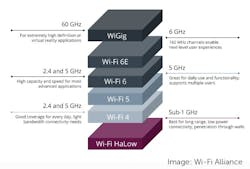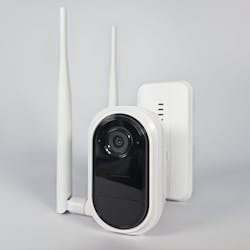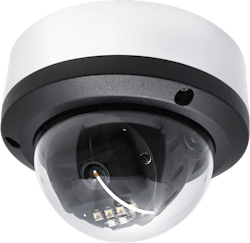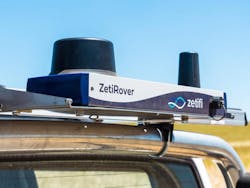This article originally appeared as part of the industry’s ONLY full CES show coverage in the February 2024 issue of Security Business magazine. Don’t forget to mention Security Business magazine on LinkedIn and @SecBusinessMag on Twitter if you share it.
LAS VEGAS – IEEE 802.11ah wireless networking protocol was published back in 2017 and eventually coined “Wi-Fi HaLow” by the Wi-Fi Alliance, which then created a certification for products incorporating the technology in 2021.
CES 2024 marked the first time we began seeing actual certified HaLow products.
Wi-Fi HaLow’s Advantage
According to the Alliance, Wi-Fi HaLow augments Wi-Fi “by operating in the spectrum below 1 gigahertz (GHz) to offer longer range and lower power connectivity.” This technology meets the unique requirements for the Internet of Things (IoT) to enable a variety of use-cases in industrial, agricultural, smart building, and smart city environments.
While conventional Wi-Fi is the most ubiquitous wireless communications protocol in use today, Wi-Fi HaLow has emerged as a superior choice for applications like wireless security cameras that require a unique combination of longer range, better penetration, lower power consumption, and support for more devices.
If you are a security integrator who has struggled to keep wireless, battery-powered cameras connected to the internet in a noisy, technology-cluttered city area, a parking garage, or a corporate campus, Wi-Fi HaLow is poised to be the game-changer that enables constant connectivity for these cameras.
If you are a residential integrator tired of receiving 10 calls a day from homeowners whose video doorbell or outdoor camera is not connecting, this technology will surely change the game. If you have residential customers who live on a sprawling piece of land – such as a farm – this technology would enable you to hang wireless security cameras and motion sensors around the perimeter of the property and stream the video and motion alerts back to a central point, from as far as three kilometers away.
No other protocol comes close to meeting the unique requirements of battery-powered wireless security cameras as effectively and efficiently as Wi-Fi HaLow. It can easily penetrate walls and other barriers and thrives in noisy environments with lots of buildings. It enables cameras at the network edge to connect wirelessly and operate on batteries, eliminating the need for Power over Ethernet cabling, making it an ideal option for smart city sensor and camera deployments as well.
In the end, the technology offers 10 times the range, 100 times the coverage area, and 1000 times the volume of traditional Wi-Fi technology. Interestingly, Wi-Fi HaLow is not proprietary. Users don’t need a special controller, a hub, or a gateway – they just plug a HaLow access point into a traditional local area network and they are ready to go. Wi-Fi HaLow not only increases wireless range; it also extends battery life with its power-saving features.
Bringing Wi-Fi HaLow to Market
Morse Micro is an Australian company that designs a Wi-Fi HaLow System on Chip (SoC), and it has led the charge in bringing Wi-Fi HaLow to market. The company explains that in testing, their Wi-Fi HaLow SoC can extend an end-device’s connectivity for nearly 3 kilometers, which is more than a mile and a half.
“It is basically a long-range, low-power alternative to regular Wi-Fi – so compared to conventional Wi-Fi, it is much lower in power and much longer in propagation,” explains Prakash Guda, Morse Micro’s VP of Product Management and Marketing. “It is much better in terms of penetration, so it enables devices to have connectivity that is more reliable, in locations where you cannot get conventional Wi-Fi.”
In conjunction with CES, Morse Micro staged the world’s first live demo of Wi-Fi HaLow technology extending three kilometers (nearly two miles) during a field test of a long-range video call in San Francisco (https://youtu.be/2xlUijXucoM).
“Our successful demo of Wi-Fi HaLow video call across three kilometers in a difficult, real-world urban environment is a major milestone for Wi-Fi connectivity, showcasing the wireless protocol’s incredible reach,” said Michael De Nil, co-founder and CEO of Morse Micro, said in a statement.
Specific advantages cited by Morse Micro include:
- For residential, HaLow is a much more reliable connection than 2.4GHz, which is very congested, and at 10x the range with lower battery consumption.
- While most enterprise deployments use PoE, there are many places where CAT6 cabling simply will not reach, such as light posts, oil rigs, construction sites, etc. HaLow can enable connectivity at a fraction of the cost of LTE in places PoE cannot reach.
- Morse Micro’s HaLow features WPA3 for extra security.
Putting it into Practice
Morse Micro has built an ecosystem of partners and ODMs in infrastructure applications and IoT devices, including indoor and outdoor IP security cameras, dual-mode Wi-Fi access points, and other IoT products. At CES, several products were introduced that leverage Morse Micro's SoC for Wi-Fi HaLow technology.
The Abode Edge Camera was touted at CES as the world’s first wireless home security camera with Edge AI and a transmission range of more than 1.5 miles, thanks to HaLow technology.
“Nearly every home security camera is facing the wrong direction,” Abode CEO Chris Carney said in a statement. “Technology constraints have limited home security cameras in two major ways: a field of view that remains fixed and facing away from the home, and rampant connectivity issues if the camera is deployed too far away.”
Adds Phil Kumin, Morse Micro’s SVP of Sales and Marketing: “Wireless cameras – and battery-operated cameras in particular – have suffered from three problems: Very poor connectivity, because the 2.4 gigahertz spectrum is very noisy and it doesn’t do well through objects and over distances, battery life, and weak AI, or in most cases, no AI. It is all about improving the user experience so that when users get a wireless camera…there won’t be a dead spot in their house where it won’t connect.”
ViewSEC’s new line of Wi-Fi HaLow-enabled security cameras supports diverse operating environments with three types of cameras:
- Outdoor bullet: Outfitted with smart edge AI, durable IP66 weatherproofing, and high-definition video clarity, these cameras are tailored for outdoors.
- Outdoor domes: Combining aesthetic appeal with edge AI and IP66 protection, these cameras deliver stable streaming for various outdoor settings.
- Indoor Wi-Fi cameras: These compact cameras provide edge AI and broad indoor coverage.
The Primax Buzz-HaLow Video Doorbell supports a wide field of view (FOV) of up to 178 degrees, including both vertical and horizontal views. Equipped with Wi-Fi and Wi-Fi HaLow connectivity, it reaches further than traditional 2.4 GHz and 5 GHz wireless protocols.
The Edgecore EAP112 Wi-Fi HaLow Router is a Wi-Fi 6 2×2 Matter gateway supporting both HaLow and 4G LTE. The router is ideal for outdoor environments and is designed to meet the rapidly growing demands of IoT applications.
Zetifi’s ZetiRover is a roaming Wi-Fi hotspot for vehicles and farm machinery. Powerful antennas and innovative multi-carrier software convert patchy coverage into fast long-range Wi-Fi for voice, video and data – on or off the farm.
Paul Rothman is Editor-in-Chief of Security Business magazine. Email him your comments and questions at [email protected]. Access the current issue, full archives, and apply for a free subscription at www.securitybusinessmag.com.
About the Author
Paul Rothman
Editor-in-Chief/Security Business
Paul Rothman is Editor-in-Chief of Security Business magazine. Email him your comments and questions at [email protected]. Access the current issue, full archives and apply for a free subscription at www.securitybusinessmag.com.






